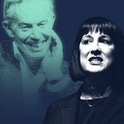Rishi Sunak’s second budget was a fiscal landmark, announcing the biggest tax rises in a generation. That diverted attention away from the accompanying economic projections from the Office for Budget Responsibility, even though these were remarkable in themselves. In particular, the OBR’s central forecast portrays a rapid recovery in GDP driven by resurgent household consumption. Will this happen? Indeed, could the rebound be stronger still if consumers spend even more than the fiscal watchdog expects?
Despite the rapid vaccination programme, the overall scoresheet on Britain’s performance during the pandemic has been dire: not only in terms of public health, but also for the economy. Among the G7, the death rate from Covid-19 has been highest in Britain, while its GDP has contracted the most.
The twin black marks are related. The tough and lengthy restrictions needed to constrain an epidemic twice allowed to get out of control hammered output, which fell by almost 10 per cent last year. With non-essential shops, pubs and restaurants closed for so long, consumer spending declined by an extraordinary 11 per cent. Since it makes up over 60 per cent of GDP, that is the main reason why the economy did so badly.
The decline in output and household consumption has continued in the first quarter of this year. But the OBR is now forecasting a big bounce back, such that GDP will regain its pre-pandemic level by the middle of 2022—six months earlier than it had anticipated in its previous outlook, published in November.
That revival will be propelled above all by consumer spending, which will return to its pre-pandemic level in early 2022, three months before GDP. The coming consumer boom shows up in the annual figures for 2022 rather than 2021. Household consumption rises by 2.9 per cent this year and 11.1 per cent in 2022. Buoyed by continuing fiscal support, especially this year, GDP increases by 4 per cent in 2021 and 7.3 per cent in 2022, the fastest growth in post-war history.
What’s more, consumers could spend even more than the OBR envisages. The blow to the economy in the past year has been quite unlike a typical broad-based recession. On this occasion, workers in hard-hit sectors such as hospitality have suffered despite the unprecedented support offered through the furlough scheme, along with help directed to the self-employed. But people working in other parts of the economy have generally continued to receive the same income as before, as have pensioners.
With fewer opportunities to spend owing to the restrictions, savings have built up in bank accounts. That windfall amounted to over £125bn by the end of 2020, according to the Bank of England. The OBR estimates that it will reach £180bn by the middle of this year. The £180bn question is what consumers will now do with this unintended pile of spare cash.
Not as much as you might think. Based on previous experience of consumers responding to gains in wealth, the Bank estimated in February that just 5 per cent of the windfall will be spent over the next three years. That chimed with a survey it conducted last autumn showing that only a tenth of households whose savings had increased during the pandemic planned to spend some of the extra funds. One reason is that the main beneficiaries have been the better-off and older, who are less likely to spend from savings.
The OBR thinks that 5 per cent of the money will be spent each year. Based on the £180bn built up by mid-2021, that means a drawdown of £9bn a year, contributing about half a percentage point to annual growth in household consumption over the next five years. Even though the OBR expects some of extra spending out of savings to be “front-loaded,” its forecast plainly does not envisage the cash pile burning a big hole in people’s pockets.
Even so, there must be a possibility that consumers will throw caution to the wind. The OBR itself wonders whether “there may be a degree of euphoria once the pandemic is past, leading households to wish to treat themselves.” In an upbeat article published by the Daily Mail in mid-February, Andy Haldane, the Bank’s chief economist, wrote: “I think there is the potential for much more, perhaps even most, of this savings pool to leak into the economy, fuelling a faster recovery. Why? Because people are not just desperate to get their social lives back, but also to catch up on the social lives they have lost over the past 12 months.”
Maybe, but in practice that’s quite hard to do. Will people really want to double up on eating out to make up for restaurant visits they couldn’t make a year ago? There’s no point in getting your hair cut more often just because you couldn’t while the salon was closed. Moreover, even when formal restrictions are lifted many people may remain cautious and maintain some form of social distancing.
On the other hand, there is clearly potential for consumers to buy more durable goods, such as cars. A useful rule of thumb is never to underestimate the resilience of the British consumer. If households do draw down their windfall savings more aggressively, we could indeed be surprised by the strength of the economic recovery.
This article has been amended to report the Bank of England estimate in February that 5 per cent of pandemic savings will be spent over three years, rather than each year












